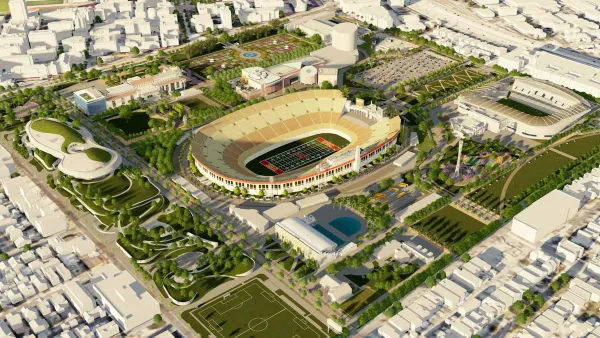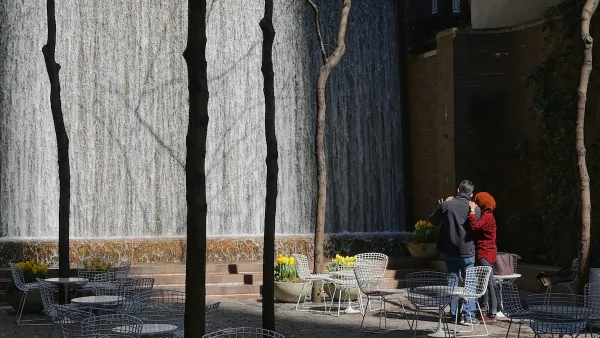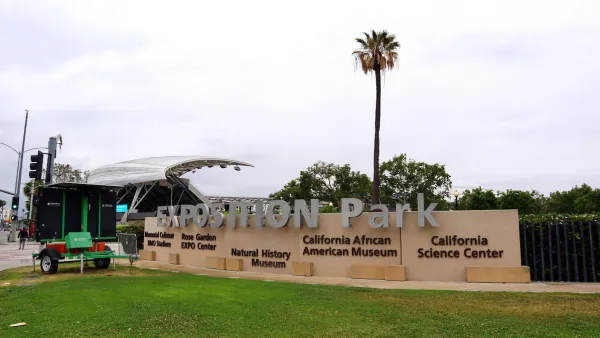After a tour of Los Angeles street furniture, Alissa Walker offers her reflections on cities' changing approach to public space.
"Thanks to some smart approaches to the way our streets are being redesigned, cities are slowly moving beyond the 'have a seat, but not for too long' mentality," writes Alissa Walker for Curbed. That mentality includes the "defensive" architecture and design that particularly targets homeless people.
Although homelessness has increasing consideration state- and nationwide, Walker posits that L.A.'s new generation of street furniture comes as a response to renewed interest in bike and pedestrian infrastructure. She writes:
This means a whole new way of thinking about how people can enjoy these spaces. Goodbye to bolted, cement-slathered seating; hello to lightweight benches, moveable planters, beach umbrellas, and cheap cafe tables and chairs—all of which can be repositioned by users.
The lightweight, "nimble" pieces reflect an approach to streetscape improvement where low-capital projects that can be easily altered or removed based on their success:
The parklets and plazas that are starting to pop up on urban streets are often pilot projects—tiny street corners carved out with temporary decking materials or, in some cases, just a different color of paint... "We like to collect data to learn from the projects and actually tweak them to evolve them," says Valerie Watson, LADOT’s assistant pedestrian coordinator.
Walker also notes that these projects are often implemented and maintained through public-private partnerships, allowing innovations like smart furniture to be sited more equitably throughout neighborhoods.
Walker notes that these projects are often done through public-private partnerships, which can allow innovations like smart furniture to be sited more equitably throughout neighborhood—although recently, a failed partnership cost Los Angeles more than 800 bus shelters throughout the city.
FULL STORY: Seats in the street: How LA's outdoor furniture creates a more livable city

National Parks Layoffs Will Cause Communities to Lose Billions
Thousands of essential park workers were laid off this week, just before the busy spring break season.

Retro-silient?: America’s First “Eco-burb,” The Woodlands Turns 50
A master-planned community north of Houston offers lessons on green infrastructure and resilient design, but falls short of its founder’s lofty affordability and walkability goals.

Delivering for America Plan Will Downgrade Mail Service in at Least 49.5 Percent of Zip Codes
Republican and Democrat lawmakers criticize the plan for its disproportionate negative impact on rural communities.

Test News Post 1
This is a summary

Test News Headline 46
Test for the image on the front page.

Balancing Bombs and Butterflies: How the National Guard Protects a Rare Species
The National Guard at Fort Indiantown Gap uses GIS technology and land management strategies to balance military training with conservation efforts, ensuring the survival of the rare eastern regal fritillary butterfly.
Urban Design for Planners 1: Software Tools
This six-course series explores essential urban design concepts using open source software and equips planners with the tools they need to participate fully in the urban design process.
Planning for Universal Design
Learn the tools for implementing Universal Design in planning regulations.
EMC Planning Group, Inc.
Planetizen
Planetizen
Mpact (formerly Rail~Volution)
Great Falls Development Authority, Inc.
HUDs Office of Policy Development and Research
NYU Wagner Graduate School of Public Service





























